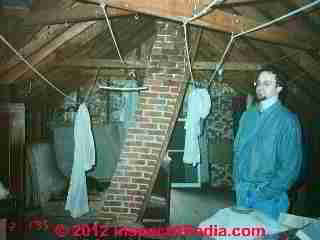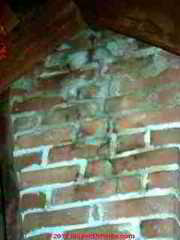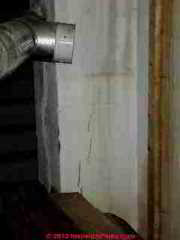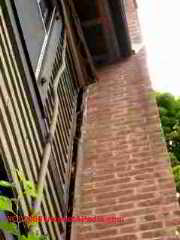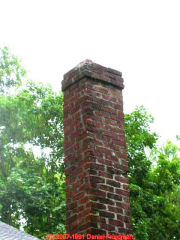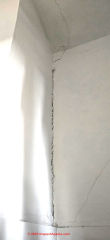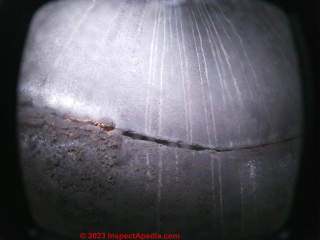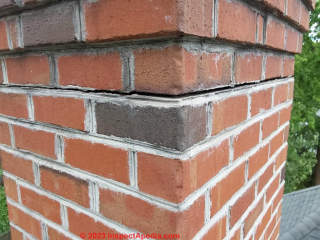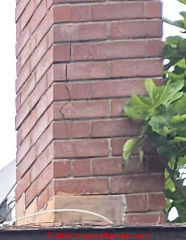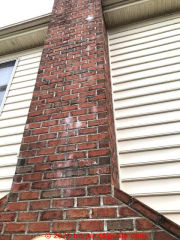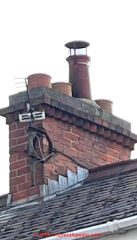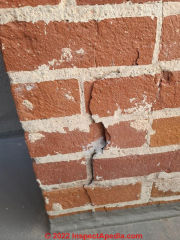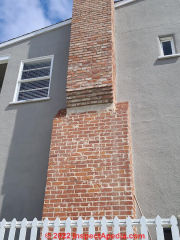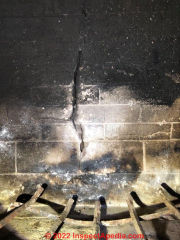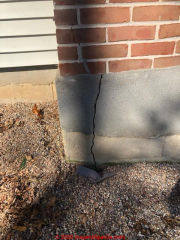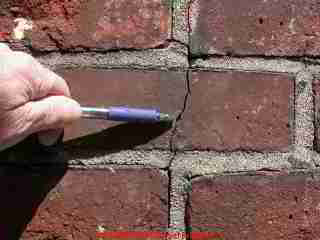 Masonry Chimney Crack Inspection & Diagnosis
Masonry Chimney Crack Inspection & Diagnosis
- POST a QUESTION or COMMENT about how to diagnose & repair chimney cracks
Diagnose cracks in chimneys:
This article catalogs the types of chimney cracks and movement that may be found in brick, stone, or concrete block chimneys; we describe the inspection and and diagnosis of the cause of each type of chimney cracking and we suggest the probable severity, safety concerns, and chimney repairs that may be necessary.
We include links to additional detailed articles about each type of chimney cracking or movement.
InspectAPedia tolerates no conflicts of interest. We have no relationship with advertisers, products, or services discussed at this website.
Cracked Brick Masonry Chimney Sides
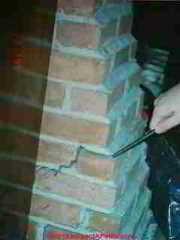 This article series on chimneys, chimney construction, and chimney safety provide detailed suggestions describing how to perform a thorough visual inspection of chimneys for safety and other defects.
This article series on chimneys, chimney construction, and chimney safety provide detailed suggestions describing how to perform a thorough visual inspection of chimneys for safety and other defects.
Chimney inspection methods and chimney repair methods are also discussed.
Guide to Diagnosing & Evaluating Cracks in Brick Chimneys
Our brick chimney photographs just above illustrate a common (and dangerous) crack pattern found in corbelled (stair-stepped) chimneys where a brick chimney passes through an attic floor and is angled over to exit at the chimney ridge.
At the chimney in our photo at above left, look very closely at the masonry joint where the chimney begins its transition from vertical to angled.
To prevent cracks in a leaned-brick chimney such as this one, the chimney depends on absolutely stable support by the roof framing structure where it passes through the roof to outside.
Unless the brick chimney was adequately supported and constructed it may lean, causing the crack pattern we show below.
Watch out: often the crack in a leaning brick chimney occurs at the attic floor where the chimney begins its transition from vertical to angled - a spot where the crack may be hard to spot.
See CHIMNEY INSPECTION INDOORS for a discussion of chimney movement that opens a hard-to-find crack where a corbelled brick chimney passes through an attic floor.
List of Typical Causes of Cracks in Brick Masonry Chimneys & Flues
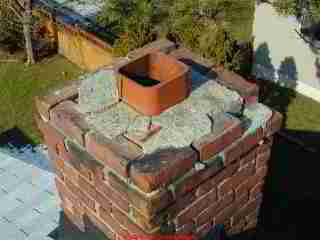 Cracks in a brick masonry chimney such as shown in these photographs may be caused by improper original chimney construction. This damage also appears on concrete block constructed chimneys.
Cracks in a brick masonry chimney such as shown in these photographs may be caused by improper original chimney construction. This damage also appears on concrete block constructed chimneys.
- Improper construction:
failure to leave air space between flue line and masonry chimney sides - if the mason does not leave an expansion gap surrounding the clay flue liners as they are set into the chimney during construction, as the flue heats up during use, the expanding flue may crack the surrounding brick. - Water leaks:
at the chimney top (missing rain cap, faulty chimney cap top seal), or at the chimney sides (defective flashing, wind-blown rain, open mortar joints) can send water into the chimney structure where in freezing climates frost can lead to cracks to the chimney itself or to its flue liner.
We illustrate water and frost damage to a brick chimney in this article, below.
Also see CHIMNEY CAP & CROWN DEFINITIONS
and CHIMNEY FLASHING MISTAKES & LEAKS.
And since water and frost can also cause surface spalling of brick or concrete block chimneys,
also see CHIMNEY SPALLING, EXTERIOR - Chimney movement:
a chimney which is set on a defective footing or foundation (more improper chimney construction) or a chimney which was not properly secured to the building may lean, bend, or curl, leading to cracks that usually appear in the mortar joints.
See BRACING for MASONRY CHIMNEYS - Thermal expansion cracks in chimneys:
a masonry chimney may crack from thermal expansion, or its internal flue may crack from thermal expansion, if the chimney was not properly constructed, failing to leave space for movement as the chimney interior heats up when in use. We illustrate thermal cracking in a brick chimney in this article, just below.
Also see THERMAL EXPANSION of MATERIALS for a table of the coefficient of expansion of common building materials. - Mechanical damaged chimney cracking:
a masonry chimney may crack due to stresses from a chimney-mounted antenna, or from earthquake or nearby site blasting stresses.
See EARTHQUAKE CHIMNEY COLLAPSE DANGERS
The second cracked chimney at above right is a bit more suspect because we see what might be traces of soot or creosote having washed out through the cracks to the chimney exterior. If this proves to be the case this flue is certainly seriously damaged.
Frost Cracking in Brick Chimneys & Flues - outdoor & indoor evidence of brick chimney damage
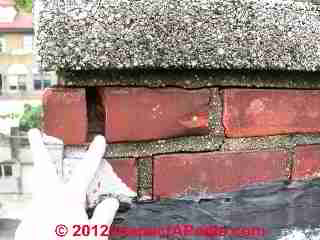
At left we show a very common crack pattern found in brick masonry chimneys & flues - water and frost cracking at the chimney top.
Considering that there is a nice thick concrete chimney cap. why do we have this brick movement and mortar-joint cracking?
Perhaps the chimney cap is cracked, flat, not draining, or it was not sealed around the flue, or a rain cap was missing.
See CHIMNEY CAP & CROWN DEFINITIONS for detailed examples of defects at the chimney top that lead to this type of chimney damage.
Also see CHIMNEY SPALLING, EXTERIOR
At below left we show a very common crack pattern found in brick masonry chimneys & flues - a collection of vertical, diagonal, and even some horizontal chimney cracks that are probably due to a combination of water intrusion and (in freezing climates) frost cracking.
Even if you do not immediately notice the chimney cracks themselves you are likely to spot this chimney damage by the creosote stains carried to the chimney surface by water entry into the chimney flue.
Of course had these cracks and stains been present on a hidden side of the chimney, say between the chimney and a close-by gable-end wall, you'd not see these clues from within the attic.
But inspecting this chimney outside, if it has had no proper rain cap and chimney cap you should be extra alert for water and frost damage to the chimney and its flue.
A second set of clues - water leak stains, may be visible in a fireplace or at a chimney cleanout lower in the building.
Thermal Cracking in Brick Chimneys & Flues May Produce Thin Vertical Openings

At left we show a very common crack pattern found in brick masonry chimneys & flues - a vertical crack that begins in a mortar joint and extends through individual bricks themselves.
Cracked chimney masonry such as shown in the photo of cracks in a brick chimney exterior (at left), may a safety concern if the flue liner or chimney are not intact and fire/gas safe.
The brick chimney crack type shown here is more often caused by thermal expansion (and improper chimney construction) than by frost - frost cracking is often more visually obvious and is often accompanied by brick spalling.
Severe Chimney Cracking - Deteriorated, Collapsing Brick or Masonry Block Chimneys
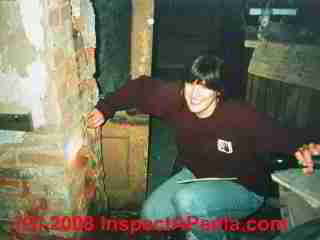 Severe chimney cracks that risk imminent chimney collapse, flue gas leaks, and fire hazards, are discussed and illustrated in detail
Severe chimney cracks that risk imminent chimney collapse, flue gas leaks, and fire hazards, are discussed and illustrated in detail
at BRICK CHIMNEY CRACKS & COLLAPSE
There we also describe a case of an imminent catastrophic chimney collapse
Also see our discussion
of CONCRETE BLOCK CHIMNEY CRACKS
Watch out: Cracks in a chimney can be very significant and dangerous, risking fire or chimney collapse.
Be sure to review the dangerous chimney collapse warnings at
at CHIMNEY COLLAPSE RISKS, REPAIRS
Cracks in Masonry Block or Concrete Block Chimneys
Cracks in a masonry chimney, particularly concrete block chimneys are often caused by
- chimney footing tipping or settlement (inadequate foundation)\
- frost (poor drainage, missing rain cap, porous masonry, improper construction in freezing climates)
- thermal expansion of the clay flue liner (improper construction)
- mechanical damage,
- or perhaps other events
See CRACKED CHIMNEYS, MASONRY BLOCK for details and additional photographs of concrete block chimney cracking.
Chimney Cracks due to Chimney Movement, Tipping, Leaning
Chimneys that lean, curve, bulge, tip, or otherwise move due to footing settlement and tipping or due to failure to secure a tall chimney to the building also may produce both visible cracks on the chimney exterior and hidden cracks and damage to the chimney flue.
The risk of an unsafe chimney flue lies behind our advice that a thorough inspection of the entire chimney flue is necessary when there is any evidence of chimney movement.
See CHIMNEY INSPECTION from GROUND for details of the detection, analysis, and repair of leaning and tipping chimneys and chimneys that have separated from their building.
Curved Brick Masonry Chimneys
Especially on older buildings using brick chimneys, and more so where the chimney flue is not lined with a modern clay liner, brick chimneys may be seen to curve in one direction.
Often all of the similar chimneys in a neighborhood curve in the same direction. It's not a coincidence. A brick chimney will often curve away from its most weather-exposed side due to sulphation - expanding brick mortar joints caused by the combination of water and sulphur or other minerals.
See CURVED BRICK CHIMNEYS, SULPHATION for further explanation of the cause, significance, and cure of curved brick chimneys.
Reader Comments, Questions & Answers About The Article Above
Below you will find questions and answers previously posted on this page at its page bottom reader comment box.
Reader Q&A - also see RECOMMENDED ARTICLES & FAQs
On 2023-11-30 by InspectApedia Publisher - keep alert for any signs of ongoing movement
@Lyndsey,
That sounds to me like you could simply do a cosmetic repair and then keep alert for any signs of ongoing movement.
On 2023-11-29 by Lyndsey
@InspectApedia Publisher,
I appreciate your response! You just took a huge weight off of my shoulders! This chimney is not in use, and the top half was actually taken off to below the roof, could this cracking been from that being done? It was done before we moved here 2 years ago. Thanks again!!
On 2023-11-29 by InspectApedia Publisher - unused chimney shaft is cracking away from drywall
@Lyndsey,
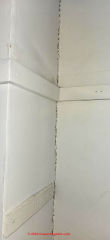 Apologies in advance that when I answer a question like this, where we have only 5% of the necessary information, I have to err on the side of caution - that is, of keeping you safe.
Apologies in advance that when I answer a question like this, where we have only 5% of the necessary information, I have to err on the side of caution - that is, of keeping you safe.
IF that cracking is simply framing settlement or shrinkage away from a stable, undamaged chimney, then it's cosmetic, trivial, and not costly to repair with a bit of drywall tape and joint compound.
but
IF the chimney itself has moved, say by leaning or settling or other sources of movement or damage (such as frost) then the hidden risk is that the internal flue liner in the chimney is cracked and damaged. If that happens then the risks are of a spark getting into the building framing - a fire risk - or that flue gases, especially from a gas fired or possibly oil fired heater leak into the occupied space.
Now if this chimney is really not in use, then there is no immediate worry about a fire or fatal CO poisoning.
Though at any home you want to be sure you have working CO Carbon Monoxide, fire & smoke detectors properly located, installed, and tested to protect from those dangers.
So what's left:
Look outside yourself for signs of a leaning or falling chimney that are visually obvious. The recommended articles on this page give step by step inspections, including simple visual clues you can see for yourself, inspecting both indoors and outside.
If the chimney were moving significantly (inches) or bulged enough that it could fall on someone, then it should be repaired or removed.
Post some more photos from inside and outside to show us what's going on and we can comment further.
On 2023-11-29 by Lyndsey
We have an unused chimney that runs through my son's closet, it looks as if it's cracking all the way down the wall.. I'm not sure if this is a huge problem or something easy to
This runs through the house, the attic looks fine and also the basement, this is the closet of my son's room where it is doing this cracking.fix?
On 2023-06-20 by InspectApedia DF (mod) - chimney relining repair project
@Jack,
The repair job you describe sounds very similar, in process and cost, to the one described here
CHIMNEY RELINING REPAIRS
You'll see the process and tools described are similar to what you've been told.
Might be a little easier for the chimney repair crew to complete the project in the summer than in the cold winter as they had to do at this Two Harbors, MN home.
I don't think I'll stainless steel chimney liners are the same and you will see that there warranty period and life expectancy varies.
In my opinion it is possible to build a all masonry chimney that could last for a hundred years or more but most people are not willing to foot the bill. My opinion which is nothing more than that is that part of the high cost of even the stainless steel solutions is a reflection of what the alternative masonry cost would be.
It would be helpful to see the photos that you taken so if there's a way that you could give us a look let me know.
On 2023-06-20 by Jack
Thanks for the reply. Yes, this was part of a comprehensive inspection of the entire system. I've 100 photos inside and out. The flue was also of concern.
Inspector recommended a rebuild of the chimney top as well as a stainless steel flue liner, knocking out all the flue liner in there now with a device called "monkey balls" inserted and operated from above, collecting the tile fragments below...
The SS flue liner would be bedded with insulating material. Expensive job (about $7k total). It seems the crown must have been lifted by the flue liner, as it sits elevated now.
Are all the SS flue liners the same? Will it last forever? Why can't we build chimneys like the ones that have been around for 200 years?
On 2023-06-19 by InspectApedia Publisher - crack that developed just beneath the crown on a chimney may be heat or frost lift
@jack,
I agree that a uniform crack like that around a chimney suggests heat or frost lift of the whole chimney - could be due to movement of the chimney tiles or liner. Frost doesn't usually lift so uniformly though I suppose there could be a special case such as flashing or concrete blockage between liner and bricks that trapped water at a specific height.
Because a damaged flue can risk fire or even dangerous CO poisoning, I would want a careful ChimScan inspection of the whole flue for fire safety and damage.
Before planning a rebuild or a liner insert, check the flue condition and let me know what you were told.
On 2023-06-19 by jack
Here's one unlike the others on this site: a crack that developed just beneath the crown on a chimney with but 13 years of light fireplace use.
This crack is below the 7th layer of brick from the top, extends horizontally around the entire chimney, and the brickwork above appears to be floating a half inch above the mortar.
Can it be that it is held up by the flue liner, that has expanded, lengthened, pushed up the crown? Will rebuild solve the problem or will it just happen again? Need a stainless flue liner, replace the clay?
On 2023-05-30 by InspectApedia Publisher - heat or moisture expansion problem might have caused chimney crack
@Chris,
It's pretty unlikely that tree roots at ground level would cause brick cracking at roof level in a chimney with the rest of the chimney intact, plumb, undamaged.
More likely was a heat or moisture expansion problem that can occur even in a CA climate without freezing.
Watch out: start by having the chimney flue inspected for safety. When we see cracks in the surrounding brick the urgent concern is that the chimney flue should be found un-damaged; else there could be a fire or carbon monoxide hazard.
On 2023-05-30 by Chris
While trimming a 10 year old fig tree planted about 6 ft from my chimney, I noticed this crack near the top. The house was built in 1974. I'm in Orange county California so no freezing, could the fig tree roots could be the problem
On 2022-10-03 y InspectApedia-911 (mod) - chimney has a hairline crack down the center
@S Patt,
It may not be safe.
The risk depends in part on how the chimney is being used and with what fuel.
The smart thing would be to have a certified Chimney Sweep inspect the flue for safety before the coming heating season.
You may not need to tear the chimney apart, it may be possible to repair it by inserting a liner.
On 2022-10-02 by S Patt
Our chimney has had a hairline crack down the center for some time. In the past 2 years it has grown in length and widened a bit. We live in the northeast so we do have freezing temps in the winter. Will the chimney likely need to be torn down and rebuilt? Is it safe to use as is for now?
On 2022-10-01 by InspectApedia (Editor) - on-site chimney expert inspection may reveal more
@Aaron,
The answer to your question is ... it depends
...
The crack I can see below that taller, capped clay flue tile is the tip of the iceberg of the question.
Are any of the individual flue tiles cracled or damaged?
Does the top crowns need repair or replacement?
Is the crack we see the only damage?
What fuels are involved?
How are the other flues used?
Why would it be ok to end all the other flue at the same height?
Why is only 1 flue capped?
What else can an on-site chimney expert inspection reveal
What is the roof covering and is it as damaged, improperly laid, and worn or fragile as the photo hints?
On 2022-10-01 by Aaron
Hello,
Would the crack shown in this chimney be an expensive repair? Would this cause a lot of moisture to get into the house?
Any advice would be greatly appreciated.
Thanks
On 2022-09-13 by InspectApedia-911 (mod) - stop using fireplace until crack cause in known
@SHAYLEIGH BANKS,
Smart.
Now I recommend an inspection by a qualified chimney sweep.
Let us know what you are told.
On 2022-09-13 by SHAYLEIGH BANKS
I've used my fireplace for two years. Last winter I notice a small crack forming. I stopped using all together when it appeared.
On 2022-08-12 by InspectApedia (mod) - How expensive is it to fix chimney?
@Kristine Pasto,
We need some further investigation because I can't see enough in your photo but it appears to me that that's some type of a brick veneer on some other surface that is forming a chimney or chimney enclosure.
To make sense out of that crack we need to know how the chimney is constructed.
Otherwise I don't know if the crack is a superficial veneer crack or if there's a structural problem, or if the chimney is settling or Frost damaged.
So how's that chimney constructed, what materials are used, and
has anyone inspected the chimney flue itself to be sure that it's safe?
On 2022-08-12 by Kristine Pasto
What would cause this type of Chimney Crack and How expensive is it likely to be when fixed?
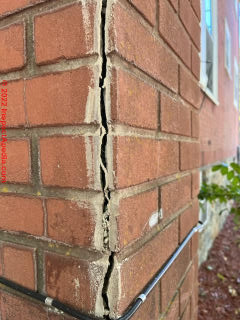
On 2021-08-22 by inspectapedia.com.moderator - how do I find the best inspector in the area
@Curious,
A complete re-build would be an un-common Rx for what we see so far - even when footing repairs are necessary, there are special approaches like using helical piers that can avoid a rebuild.
Talk to a couple of masons and a couple of engineers - structural or civil, not electrical or someone else who might be practicing out of their area of training and specialty) - ask what they will do on site, what kind of report you'll get, about how much time is typically needed to inspect; listen for someone who has experience with residential masonry and chimney structures, diagnosis, and repair.
Anyone who bullies or says "don't worry honey we'll take care of it" is someone you don't want.
On 2021-08-22 by Curious
@inspectapedia.com.moderator, Thank you! Now my question is how do I find the best inspector in the area, who will give me the straight scoop.
We already paid to rebuild the top half of the chimney and reinforce it -- I don't want to have to tear down it all down again and rebuild unless absolutely neccesary. And what should we expect to pay for a proper inspection?
On 2021-08-20 by inspectapedia.com.moderator - chimney and flue need to be inspected completely
@Curious,
Apologies for taking a while: I looked at your photos earlier today but had to think some before blabbing off a guess at what's going on.
In LA, you're not in a freezing zone, so I'm skipping the water and frost causes.
I can see only a fraction of what an experienced mason or residential-structure-masonry-engineer would see on-site, but to me this looks like a fracture caused by weight of the masonry above.
The underlying problem could have been (example guesses)
Footing not properly prepped or not placed on solid virgin soil - settled or cracked
or
a couple of soft bricks or bricks with voids that crushed, extending the damage to their neighbors
or, of course
something else I can't see
Watch out: what's most important here is safety, starting with chimney flue condition and safety: we want to be certain that this split brick is only at a brick veneer and that the chimney structure (typically masonry block and clay flue tile liners) is intact.
A damaged chimney flue can leak fatal carbon monoxide gas into the building or even risk a building fire.
So you want your chimney and flue inspected completely, perhaps using a chimscan camera by a certified chimney professional - to assure the flue is safe.
That inspector may then have an opinion about what repairs are appropriate to assure the continued safety of the chimney liner and structure.
Let me know what you're told: that will be valuable to us and to other readers.
Thanks
On 2021-08-20 by Curious
I am in Los Angeles. We have a gas burning firplace (no wood used). This crack is by the base. There is about 5 feet of chimney beneath this point and 25 feet above. We had the top 15 feet rebuild 15 years ago and reinforced (originally built in the 30's).
Doesn't seem to be getting worse but have no watched it religiously. Here is a pic of the entire chimney, too. The crack is at lower left, not visible here. Thoughts? And thank you.
On 2021-06-05 by inspectapedia.com.moderator - degrading of chimney brick from moss growth
@John Bruce McGonigal,
How interesting, I'll do some research. I haven't seen a special term for the effect of moss on masonry chimneys.
I expect that the issues would be water damage or frost damage exacerbated by moss holding water on to the masonry surface.
How that damage shows up is probably what determines its name.
For example cracking, or spalling.
On 2021-06-04 by John Bruce McGonigal
Is there a word to describe the degrading of chimney brick from moss growth?
On 2021-03-04 by danjoefriedman (mod) - follow the advice of thorough chimney inspection
@Valerie fahey,
Particularly where fire and life safety questions are involved, no one can possibly give you safe advice about whether or not you can light a fire in your fireplace based on a brief text nor even really on just reading a report and then second-guessing what the inspector said.
If your thorough inspection of the chimney - your words - ended with a recommendation that the chimney was unsafe and should not be used until it is repaired, then you should follow that advice as the safest course.
On 2021-03-04 by Valerie fahey
Hi there, I had a thorough inspection of my chimney at which several of the vertical flue tiles were found to have hairline cracks. There were also some open mortar joints. All in all, the inspector said to discontinue use until a 5k repair was made but didn’t seem too concerned about these hairline cracks at all and thought it to be normal.
He said the fireplace had a special cone shaped flue that was the best of the best for even today’s standard’s as it was built in 1922. The guy left the company and I am thinking it would be okay to have a fire there but also a little apprehensive at the same time.
The cracks are so minuscule! The images are in the report so i would have to send them via e-mail to a private address.
On 2021-02-16 by danjoefriedman (mod) - large fireplace crack needs further investigation
@CF,
Having been present in a house that caught fire from an improperly constructed masonry fireplace, I don't rely simply on opinion.
Just how dangerous that crack is depends on how your fireplace and chimney were constructed.
But from what I can see it's significant enough that it's definitely worth further investigation before simply repairing the crack.
I would want to know if there is a risk of flue gases or Sparks escaping into the building and setting it on fire and I would want to know if there's a risk of collapse.
On 2021-02-16 by CF
Hello, Our house (and I suspect this chimney) was built in 1950. We have lived here since 2014 and have never used the fireplace because it has a large crack (pic attached). Today I contacted a local chimney sweep requesting a cleaning and repair and attached an image of the crack.
I was told that chimney cracks are "very normal" and "nothing to worry about". I do not agree. Does this seem safe to use? Also do you have any idea the cause? Thank you.
On 2021-02-04 - by (mod) -
It certainly sounds as if it's worth having a more thorough chimney inspection for cracks and damage that are sending water down through the chimney flue, structure, or other openings such that it leaks into your floor and is damaging the floor. See if you can find a chimney sweep who has a Chim scan camera.
On 2021-01-31 by Brendan
About ten years ago my chimney was hit by lightning and blew the exposed top completely off the house. I had a chimney repair person install new top and fill any cracks on the fireplace caused by the strike. In time i noticed the laminate flooring was separating.
A couple of ceiling leaks, the subflooring in my family room was bouncy . Other electric was damaged such as furnace washer dryer etc. I was just wandering has anyone else had this experience this problem.
On 2020-12-17 by (mod) - lightning damage to masonry chimney?
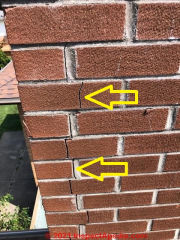 Joe:
Joe:
Lightning strikes can vaporize moisture and cause all sorts of crazy damage, including cracking masonry chimneys, even slabs and buildings;
but I can't say a thing conclusively from just your photo.
Frost damage, moisture damage, and in long brick walls, thermal expansion can also cause vertical and stepped cracks.
I suspect your damage may be from frost. (In what climate is this chimney located?)
Examine the opposite end of the same wall and the other building corners and show me if those have cracks.
On 2020-12-17 by Joe
Hey I was just wondering if it was possible that lightning could have caused this damage?
On 2020-10-19 by Debra Blizzard
What is the proper procedure for applying stucco over a chimney that hass moss in mortor joints
On 2020-10-02 - by (mod) -
Looks like moisture behind the veneer or poor connections of veneer to the structure behind it or, movement in the supporting structure itself.
A better installation would have included a top crown (that thin concrete wash atop the chimney) that extended out an inch or so past the vertical surfaces of the veneer walls so as to be sure we're not leaking water into the chimney chase.
Also I can't see the chimney flashing- I suspect the veneer was installed over the flashing or counter flashing; but we can't see just what was present - so be sure to check the roof interior below this area for leaks.
An ugly repair might be silicone in those cracks but I'm doubtful; if you push on the veneer does it move? That'd be diagnostic.
Probably the only real repair is to tear all of this off, inspect and if necessary fix the supporting structure, fix any flashing errors, install new veneer properly secured, install a proper top crown, reinstall top chimney cap
On 2020-10-02 by Ryan
These were done 8 months ago. They reframed and re bricked (thin veneer bricks not typical size bricks) The cracks are similar to what happened to chimneys that were there for 25 years. The cracks are mainly at the corners. Any help would be appreciated.
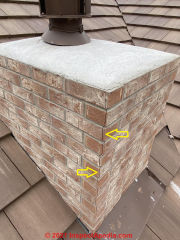
On 2020-09-22 - by (mod) -
Miss J
No, sorry but we cannot offer to repair the damage to your chimney. InspectAPedia.com provides building and environmental diagnostic and repair information. In order to absolutely assure our readers that we write and report without bias we do not sell any products nor services, nor do we have any business or financial relationships that could create such conflicts of interest.
But we can offer advice, suggest questions to ask, and help you sort through most building and environmental problems.
I would start by hiring a professional certified chimney sweep or repair company and I would have them inspect the entire chimney flue. We don't know if the damage is trivial, confined to a to clay flue tile liner (remove and replace) or if there is more extensive damage that makes the flue unsafe.
Let me know what you're told, post photos (one per comment, as many comments as you need), and we can take it from there.
InspectAPedia is an independent publisher of building, environmental, and forensic inspection, diagnosis, and repair information for the public - we have no business nor financial connection with any manufacturer or service provider discussed at our website. We very much welcome critique, questions, or content suggestions for our web articles.
More about us is at ABOUT InspectApedia.com https://inspectapedia.com/Admin/About_InspectApedia.php
On 2020-09-22 by MISS J THURSTON
I thought my roof was leaking so I phoned the company I already had work done by. After their Roofer looked at it he told reassured me my roof was not leaking .
I saw him taking photos and asked if I had rain coming down my Chimney. I replied yes. He took more photos. Then came down of the roof. On this he shown me a crack in the chimney stack.
I was wondering if you could give me a reasonable quote to have this problem resolved as I am a oap. Yours sincerely Miss J Thurston. Thank you very much. I look forward to hearing from you.
On 2020-07-26 by M
Expert said it was likely due to shifting, but only looked at emailed photos. Quoted 2600 USD to tear down to roof level.
On 2020-07-24 - by (mod) - very dangerous chimney: collapse risk, fire risk, carbon monoxide poisoning risk. Not usable.
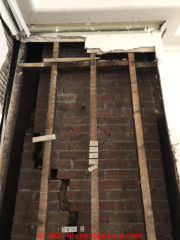 There are two serious safety hazards here
There are two serious safety hazards here
Watch out: A chimney collapse, injuring someone nearby and damaging the building,
And
Watch out: there is a near-certain risk of fatal carbon monoxide poisoning or a building fire if the chimney in use.
1. Rope off the area and keep people away pending an onsite expert's help
2. Make certain no oil or gas or other fueled equipment is using the chimney.
One would need to inspect the whole chimney down to its footing to understand the exact cause, but almost certainly this chimney is beyond economic repair. It needs to be removed and replaced.
On 2020-07-24 by christopher ricci
I have a chimney that cracked badly and seperated from the wall. it was due to pile driving behind our building. it is very hard to tell what is happening with the chimney or how it was attached to the building. it looks as though it detached from one side of the wall and is pushing the other side.
i can see into the chimney , oddly enough the chimney crack stops on the inside and doesn't travel to the outer chimney, it is inside of my building so I dont have any idea how to take it down. can i leave it alone, as it seams like such a massive project that i dont think we can afford to have it removed. ( probbaly cant afford not to have it removed.)
I have had contractors say it might fall down. does the outside chimney connect with the inside chimney ? can they be two serperate structures? or are they constructed all in one structure? it is so massive i am affraid to touch it anywhere.
I have tried to pull the sheetrock away from the structure. unfortunately alot of the building has decorative moldings, and paneling .. It looks like the chimney is pushing on one side of the wall due to cracks along the wall. i have had no water come in but i can see daylight, into the chimney. its bad
On 2020-07-19 - by (mod) -
Please let me know what you are told.
On 2020-07-19 by Anonymous
I should have clarified that "leaking" was more of a staining. It's not as if it's pooling or a serious issue at all; just evidence that there is/was water.
Because this is more complicated than I thought it would, I'm going to have it looked at (in person!) by a professional.
Thanks for all your help.
On 2020-07-17 - by (mod) -
It would be worth looking carefully at the chimney to be sure we know where the water is entering. E.g. water can enter at the top from a missing rain cap or missing top or crown seal, run down between the flue and the block or masonry of the chimney, and cause frost damage.
The correct pattern does suggest water coming in from the top or somewhere on the chimney height above ground. Feeling the top is reasonable if you can absolutely prevent the chimney from being used in the future..
I would want to be sure that I don't have a problem with ground water leaking into the chimney base because if we don't fix that will continue to have water entry in the basement. Let's resolve the Water Source question first
On 2020-07-15 by M
Thanks for the quick response. Yes I'm in a freezing climate in Ontario, Canada.
It's not connected to a fireplace, it really never will be used again. It was used by an oil furnace which has since been replaced for natural gas. The opening into the basement to which it connects was "sealed" but is leaking dirty water, so yes water seems to be an issue.
Would you suggest sealing the flue at the top? I've seen online tutorials using sheet metal and silicone caulk. If I do that, should I not seal the basement opening?
I'm also considering having the chimney removed to play it safe.
On 2020-07-15 - by (mod) - vertical crack at the center of a masonry chimney
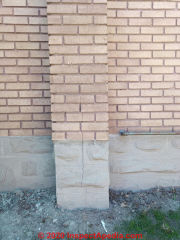 M
M
I am in no position, here far away and with only one photo, to argue with whomever your onsite expert was. Weight might cause masonry to split in the middle, but so might frost from water running inside the masonry chimney, perhaps from a bad top seal, crown, or missing cap.
Are you in a freezing climate? If not we'll rule that explanation out.
Chimneys do not normally split from their own weight.
A bad or settling chimney footing under a masonry chimney can cause cracking but I think the cracks would be different in location and pattern.
Besides, that, the most-important point is this:
Watch out: the serious risk is of an unsafe chimney flue, risking fire or fatal carbon monoxide hazards. You should have the flue inspected by a certified chimney sweep - for safety - before continuing to use this flue. That inspection can give us an idea about what repair is most-appropriate.
Let me know what you're told and I can offer some further suggestions.
On 2020-07-15 by M
I have this crack from the base on an unused chimney stack, I've been told that it's because of the weight of the chimney and that it's sticking out from the house. Thoughts?
On 2019-02-08 - by (mod) -
Mayra
In your photo I see fine hairline cracks right through the middle of what looks like bricks - in a brick and mortar masonry chimney.
I have so little information that I can only guess that the bricks may have cracked from thermal changes in the chimney or maybe even overheating.
You would be wise and safer to have the chimney inspected by a certified chimney sweep (National Chimney Sweeps Guild if you are in the U.S.)
not just for the crack we see, but to assure that the interior flue is intact and safe.
IF the chimney is indeed significantly damaged it may be repairable by re-lining, but gee that's just speculation from a very limited image.
On 2019-02-08 by torres.mayra.g
I am interested in buying a house. However, I am concern because the chimney has many cracks. What could the cause of such cracks be?
IMAGE LOST by older version of Clark Van Oyen’s useful Comments code - now fixed. Please re-post the image if you can. Sorry. Mod.
Question:
Recently noticed this crack along my chimy. We've lived here about a year and not sure if this was there when we moved and we (along with inspection) missed it or its new.
Any suggestions?
Measured it and its between 1/8 and 1/16 of an inch wide.
Thanks in advance!
This Q&A were posted originally at CONSULTANTS & EXPERTS DIRECTORIES
Moderator reply:
DP:
We need more details to make even a wild guess at cause, impact, & repair of this chimney foundation crack;
I agree that it's big enough to warrant investigation and at the very least, sealing, possibly other repair.
On the other hand, I don't see cracks extending up from the concrete base into the body of the chimney.
Watch out: the first safety question that occurs to us is the risk of a cracked, damaged chimney flue - risking fire or fatal CO poisoning. So you might start by asking a certified chimney sweep for a thorough inspection of the chimney flue for safety.
Some additional diagnostic questions:
- Does this home have a basement?
- How old is the home.
- What are the country and city of location?
- In the basement is there heating equipment venting into this chimney?
- In the basement is there a chimney cleanout access opening? If so open it and look for signs of water entry and also - important - tell me if the bottom of the cleanout chamber is at the same level as the basement floor slab or higher.
...
Continue reading at CRACKED CHIMNEYS, MASONRY BLOCK or select a topic from the closely-related articles below, or see the complete ARTICLE INDEX.
Or see CHIMNEY CRACK DETECTION & DIAGNOSIS FAQs - questions & answers posted originally on this page.
Or see these
Recommended Articles
- CHIMNEY COLLAPSE RISKS, REPAIRS
- CHIMNEY CRACK DETECTION & DIAGNOSIS
- BRACING for MASONRY CHIMNEYS
- BRICK CHIMNEY CRACKS & COLLAPSE
- CHIMNEY COLLAPSE RISKS, REPAIRS
- CHIMNEY DAMAGE by LEAKS & FROST
- CHIMNEY FLUE INSPECTION CAMERA
- CHIMNEY FOOTING DEFECTIVE / MISSING
- CHIMNEY INSPECTION DIAGNOSIS REPAIR - home
- CHIMNEY INSPECTION INDOORS
- CHIMNEY INSPECTION OUTDOORS
- CHIMNEY INSPECTION from GROUND
- CONCRETE BLOCK CHIMNEY CRACKS
- CURVED BRICK CHIMNEYS, SULPHATION
- EARTHQUAKE CHIMNEY COLLAPSE DANGERS
- SPLIT OPENINGS in BRICKS, CHIMNEY COLLAPSE
- CHIMNEY DAMAGE by LEAKS & FROST
- SOIL PROPERTIES & BUILDING FAILURES
Suggested citation for this web page
CHIMNEY CRACK DETECTION & DIAGNOSIS at InspectApedia.com - online encyclopedia of building & environmental inspection, testing, diagnosis, repair, & problem prevention advice.
Or see this
INDEX to RELATED ARTICLES: ARTICLE INDEX to CHIMNEYS & FLUES
Or use the SEARCH BOX found below to Ask a Question or Search InspectApedia
Ask a Question or Search InspectApedia
Try the search box just below, or if you prefer, post a question or comment in the Comments box below and we will respond promptly.
Search the InspectApedia website
Note: appearance of your Comment below may be delayed: if your comment contains an image, photograph, web link, or text that looks to the software as if it might be a web link, your posting will appear after it has been approved by a moderator. Apologies for the delay.
Only one image can be added per comment but you can post as many comments, and therefore images, as you like.
You will not receive a notification when a response to your question has been posted.
Please bookmark this page to make it easy for you to check back for our response.
Our Comment Box is provided by Countable Web Productions countable.ca
Citations & References
In addition to any citations in the article above, a full list is available on request.
- Roger Hankeyis principal of Hankey and Brown home inspectors, Eden Prairie, MN, technical review by Roger Hankey, prior chairman, Standards Committee, American Society of Home Inspectors - ASHI. 952 829-0044 - hankeyandbrown.com
- NFPA 211 - Standards for Chimneys & Fireplaces, NFPA 211: Standard for Chimneys, Fireplaces, Vents, and Solid Fuel-Burning Appliances, 2006 Edition (older editions and standards are found at the same bookstore)
- NFPA #211-3.1 1988 - Specific to chimneys, fireplaces, vents and solid fuel burning appliances.
- NFPA # 54-7.1 1992 - Specific to venting of equipment with fan-assisted combustion systems.
- GAMA - Gas Appliance Manufacturers' Association has prepared venting tables for Category I draft hood equipped central furnaces as well as fan-assisted combustion system central furnaces.
- National Fuel Gas Code, an American National Standard, 4th ed. 1988 (newer edition is available) Secretariats, American Gas Association (AGA), 1515 Wilson Blvd., Arlington VA22209, and National Fire Protection Association (NFPA), Batterymarch Park, Quincy MA 02269. ANSI Z223.1-1988 - NFPA 54-1988. WARNING: be sure to check clearances and other safety guidelines in the latest edition of these standards.
- Fire Inspector Guidebook, A Correlation of Fire Safety Requirements Contained in the 1987 BOCA National Codes, (newer edition available), Building Officials and Code Administrators International, Inc. (BOCA), Country Club HIlls, IL 60478 312-799-2300 4th ed. Note: this document is reissued every four years. Be sure to obtain the latest edition.
- Uniform Mechanical Code - UMC 1991, Sec 913 (a.) Masonry Chimneys, refers to Chapters 23, 29, and 37 of the Building Code.
- New York 1984 Uniform Fire Prevention and Building Code, Article 10, Heating, Ventilating, and Air Conditioning Requirements
- New York 1979 Uniform Fire Prevention & Building Code, The "requirement" for 8" of solid masonry OR for use of a flue liner was listed in the One and Two Family Dwelling Code for New York, in 1979, in Chapter 9, Chimneys and Fireplaces, New York 1979 Building and Fire Prevention Code:
- "Top Ten Chimney (and related) Problems Encountered by One Chimney Sweep," Hudson Valley ASHI education seminar, 3 January 2000, contributed by Bob Hansen, ASHI
- Chimney Inspection Checklist, Carson Dunlop, Associates, Toronto, Ontario
- "Rooftop View Turns to Darkness," Martine Costello, Josh Kovner, New Haven Register, 12 May 1992 p. 11: Catherine Murphy was sunning on a building roof when a chimney collapsed; she fell into and was trapped inside the chimney until rescued by emergency workers.
- "Chimneys and Vents," Mark J. Reinmiller, P.E., ASHI Technical Journal, Vol. 1 No. 2 July 1991 p. 34-38.
- "Chimney Inspection Procedures & Codes," Donald V. Cohen was to be published in the first volume of the 1994 ASHI Technical Journal by D. Friedman, then editor/publisher of that publication. The production of the ASHI Technical Journal and future editions was cancelled by ASHI President Patrick Porzio. Some of the content of Mr. Cohen's original submission has been included in this more complete chimney inspection article: CHIMNEY INSPECTION DIAGNOSIS REPAIR . Copies of earlier editions of the ASHI Technical Journal are available from ASHI, the American Society of Home Inspectors.
- Natural Gas Weekly Update: http://tonto.eia.doe.gov/oog/info/ngw/ngupdate.asp Official Energy Statistics from the U.S. Government
- US Energy Administration: Electrical Energy Costs http://www.eia.doe.gov/fuelelectric.html
- Ceramic Roofware, Hans Van Lemmen, Shire Library, 2008, ISBN-13: 978-0747805694 - Brick chimneys, chimney-pots and roof and ridge tiles have been a feature of the roofs of a wide range of buildings since the late Middle Ages. In the first instance this ceramic roofware was functional - to make the roof weatherproof and to provide an outlet for smoke - but it could also be very decorative. The practical and ornamental aspects of ceramic roofware can still be seen throughout Britain, particularly on buildings of the Victorian and Edwardian periods. Not only do these often have ornate chimneys and roof tiles but they may also feature ornamental sculptures or highly decorative gable ends. This book charts the history of ceramic roofware from the Middle Ages to the present day, highlighting both practical and decorative applications, and giving information about manufacturers and on the styles and techniques of production and decoration. Hans van Lemmen is an established author on the history of tiles and has lectured on the subject in Britain and elsewhere. He is founder member and presently publications editor of the British Tiles and Architectural Ceramics Society.
- Chimney Inspection Checklist, Carson Dunlop, Associates, Toronto, Ontario
- Chimney & Stack Inspection Guidelines, American Society of Civil Engineers, 2003 - These guidelines address the inspection of chimneys and stacks. Each guideline assists owners in determining what level of inspection is appropriate to a particular chimney and provides common criteria so that all parties involved have a clear understanding of the scope of the inspection and the end product required. Each chimney or stack is a unique structure, subject to both aggressive operating and natural environments, and degradation over time. Such degradation may be managed via a prudent inspection program followed by maintenance work on any equipment or structure determined to be in need of attention. Sample inspection report specifications, sample field inspection data forms, and an example of a developed plan of a concrete chimney are included in the guidelines. This book provides a valuable guidance tool for chimney and stack inspections and also offers a set of references for these particular inspections.
- Fireplaces, a Practical Design Guide, Jane Gitlin
- Fireplaces, Friend or Foe, Robert D. Mayo
- NFPA 211 - Standards for Chimneys & Fireplaces, NFPA 211: Standard for Chimneys, Fireplaces, Vents, and Solid Fuel-Burning Appliances, 2006 Edition (older editions and standards are found at the same bookstore)
- Principles of Home Inspection: Chimneys & Wood Heating, in (Principles of Home Inspection), Carson Dunlop, Associates, Toronto, Ontario
- U.S. vs. Canadian Unlined Masonry Chimney Flue Requirements & Case Study
- NFPA 211 - 3-1.10 - Relining guide for chimneys
- NFPA 211 - 3-2 - Construction of Masonry Chimneys
- NFPA 211 - 3-3 - Termination Height for chimneys
- NFPA 211 - 3-4 - Clearance from Combustible Material
- NFPA 54 - 7-1 - Venting of Equipment into chimneys
- Brick Institute of America - Flashing Chimneys
Brick Institute of America - Proper Chimney Crowns
Brick Institute of America - Moisture Resistance of Brick - American Gas Association - New Vent Sizing Tables
- Chimney Safety Institute of America - Chimney Fires: Causes, Effects, Evaluation
- National Chimney Sweep Guild - Yellow Pages of Suppliers
- In addition to citations & references found in this article, see the research citations given at the end of the related articles found at our suggested
CONTINUE READING or RECOMMENDED ARTICLES.
- Carson, Dunlop & Associates Ltd., 120 Carlton Street Suite 407, Toronto ON M5A 4K2. Tel: (416) 964-9415 1-800-268-7070 Email: info@carsondunlop.com. Alan Carson is a past president of ASHI, the American Society of Home Inspectors.
Thanks to Alan Carson and Bob Dunlop, for permission for InspectAPedia to use text excerpts from The HOME REFERENCE BOOK - the Encyclopedia of Homes and to use illustrations from The ILLUSTRATED HOME .
Carson Dunlop Associates provides extensive home inspection education and report writing material. In gratitude we provide links to tsome Carson Dunlop Associates products and services.


